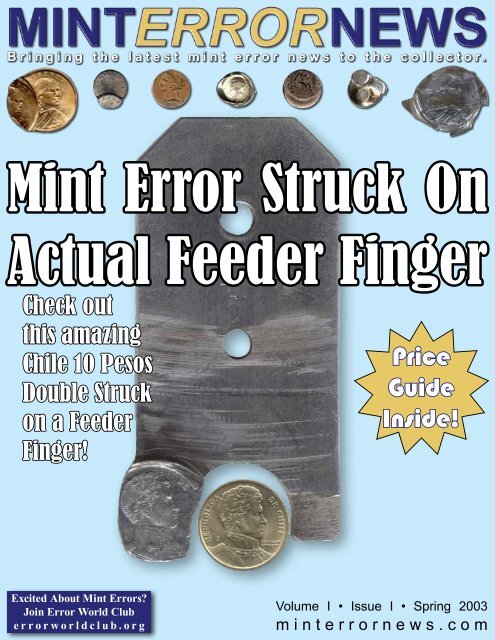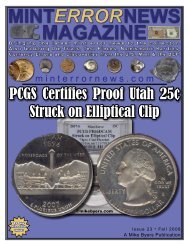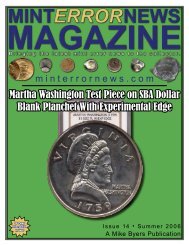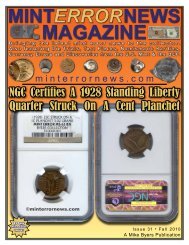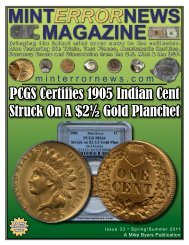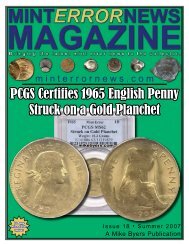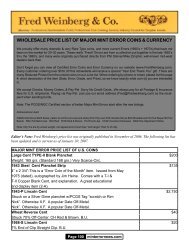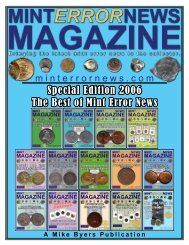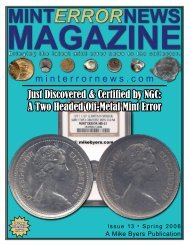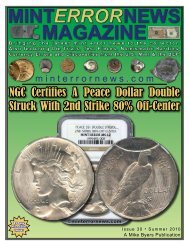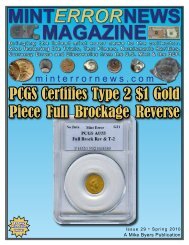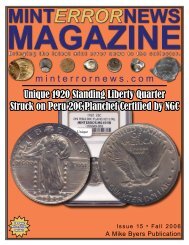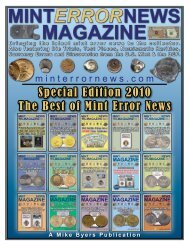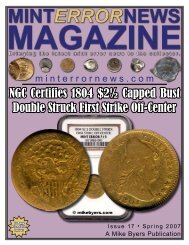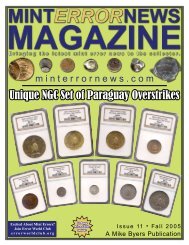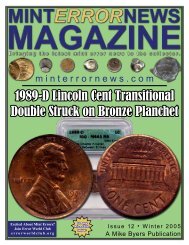Issue 1 - Mint Error News Magazine
Issue 1 - Mint Error News Magazine
Issue 1 - Mint Error News Magazine
You also want an ePaper? Increase the reach of your titles
YUMPU automatically turns print PDFs into web optimized ePapers that Google loves.
<strong>Mint</strong> <strong>Error</strong> Struck On<br />
Actual Feeder Finger<br />
Check out<br />
this amazing<br />
Chile 10 Pesos<br />
Double Struck<br />
on a Feeder<br />
Finger!<br />
Excited About <strong>Mint</strong> <strong>Error</strong>s?<br />
Join <strong>Error</strong> World Club<br />
errorworldclub.org<br />
Price<br />
Guide<br />
Inside!<br />
Volume I • <strong>Issue</strong> I • Spring 2003<br />
minterrornews.com
Al’s Coins<br />
Dealer in <strong>Mint</strong> <strong>Error</strong>s<br />
and Currency <strong>Error</strong>s<br />
alscoins.com<br />
Specializing in <strong>Mint</strong> <strong>Error</strong>s and Currency<br />
<strong>Error</strong>s for 25 years. Visit my website to<br />
see a diverse group of type, modern mint<br />
and major currency errors. We also handle<br />
regular U.S. and World coins.<br />
I’m a member of CONECA and the American<br />
Numismatic Association. I deal with major<br />
<strong>Mint</strong> <strong>Error</strong> Dealers and have an excellent<br />
standing with eBay. Check out my show<br />
schedule to see which major shows I will be<br />
attending. I solicit want lists and will locate<br />
the <strong>Mint</strong> <strong>Error</strong>s of your dreams.<br />
Al’s Coins<br />
P.O. Box 147<br />
National City, CA 91951-0147<br />
Phone: (877) 442-3728<br />
Fax: (619) 442-3693<br />
e-mail: alscoins@aol.com
Volume I • <strong>Issue</strong> I • Spring 2003<br />
Publisher and Editor<br />
Mike Byers<br />
Production Design<br />
Sam Rhazi<br />
Contributing Editors<br />
Fred Weinberg<br />
Allan Levy<br />
Contributing Writers<br />
James Archibald<br />
Ray Gaudette • Bert Hickman<br />
Henry Hilgard • Terry Holcomb<br />
Mike Moloney • J.T. Stanton<br />
Saul Teichman • Martin Wettmark<br />
Advertising<br />
The ad space is sold out. Please e-mail<br />
editor@minterrornews.com to be added<br />
to the waiting list.<br />
Subscriptions<br />
For a complimentary issue please e-mail<br />
editor@minterrornews.com<br />
<strong>Mint</strong> <strong>Error</strong> <strong>News</strong> is the official publication<br />
of minterrornews.com. All content<br />
Copyright 2003 <strong>Mint</strong> <strong>Error</strong> <strong>News</strong>. P.O.<br />
Box 5090, San Clemente, CA 92674. All<br />
rights reserved. No part of this magazine<br />
may be reproduced in any form without<br />
the expressed written permission of the<br />
publisher. Opinions expressed in this publication<br />
do not necessarily represent the<br />
viewpoints of <strong>Mint</strong> <strong>Error</strong> <strong>News</strong>. This publication<br />
is distributed with the understanding<br />
that the information presented herein is<br />
from various sources for which there can<br />
be no warranty or responsibility by the<br />
publisher as to accuracy, price or completeness.<br />
<strong>Mint</strong> <strong>Error</strong> <strong>News</strong> accepts unsolicited<br />
manuscripts, artwork, and photographs for<br />
publication. Direct editorial submissions<br />
to editor@minterrornews.com or P.O. Box<br />
5090, San Clemente, CA 92674. All unsolicited<br />
material will not be returned.<br />
PRINTED IN THE U.S.A.<br />
<strong>Mint</strong> <strong>Error</strong> <strong>News</strong><br />
Welcome 4<br />
2000-P Massachusetts Quarter Struck on an<br />
Experimental Planchet<br />
5<br />
The Real Story Behind The Aluminum Feeder<br />
Finger Find<br />
7<br />
Chile 10 Pesos Double Struck on Feeder Finger 9<br />
Is a “Double <strong>Error</strong>” Large Cent More Valuable? 11<br />
“Shrunken Coins” and How to Recognize Them 12<br />
Al’s Perspective on 2002 & 2003 <strong>Mint</strong> <strong>Error</strong>s... 14<br />
Pattern or <strong>Mint</strong> <strong>Error</strong>? 15<br />
Wow, <strong>Error</strong> Prices Have Changed 17<br />
1865 2¢ Obverse Die Cap & Brockage Sells For<br />
Record Price<br />
18<br />
<strong>Mint</strong> <strong>Error</strong> <strong>News</strong> Price Guide 21<br />
Where Have All of the Coins Gone? 26<br />
<strong>Error</strong> World Club / <strong>Mint</strong> <strong>Error</strong> <strong>News</strong> Contest 29<br />
Exclusive Discounts 30<br />
Eureka Trading Systems Introduces <strong>Error</strong> Section 31<br />
Specific Gravity 32<br />
1999 SBA Dollar Cap on a Struck Georgia Quarter 34<br />
The Story Behind An Interesting Overstrike Coin 35<br />
Double Struck French 5 Francs on Spoon!! 36<br />
The Amazing Broken CC and Other <strong>Error</strong>s on<br />
Display<br />
37<br />
A Fascinating 1790 Mule 38<br />
Triple Struck Double Denom Rev Brockage Off<br />
Metal -OR- Triple Denom?.... That is the Question<br />
39<br />
Two-Headed & Two-Tailed Coins 40<br />
Frequently Asked Questions 42<br />
Page 3 minterrornews.com
Welcome to <strong>Mint</strong> <strong>Error</strong> <strong>News</strong>, bringing<br />
the latest mint error news and<br />
information to the collector.<br />
The focus of the magazine will be on<br />
articles, features and discoveries of major<br />
mint errors (striking errors) from the United<br />
States and around the World. The website<br />
minterrornews.com was launched on February<br />
4, 2003. <strong>Mint</strong> <strong>Error</strong> <strong>News</strong> is sponsored by<br />
Mike Byers and ANACS.<br />
Mike Byers (mikebyers.com) has been<br />
a Professional Numismatist since 1978. He<br />
specializes in U.S. and World errors, and is<br />
now the largest dealer of the world’s rarest<br />
mint errors. His new discoveries of major<br />
mint errors has been front page news for<br />
years. Mike Byers is also a Consultant to<br />
ANACS for <strong>Mint</strong> <strong>Error</strong>s.<br />
Welcome<br />
Page 4 minterrornews.com<br />
ANACS (www.anacs.com) is one of the<br />
three major grading services. They have been<br />
authenticating, certifying and encapsulating<br />
mint errors since 1991 which is years longer<br />
than the other two grading services combined.<br />
ANACS is highly respected in the Numismatic<br />
Community and has extensive experience in<br />
authenticating mint errors.<br />
The two major contributors are Tim<br />
Bullard (errorcointrader.com) and Allan Levy<br />
(alscoins.com). Because of their combined<br />
experience and insight of the error coin<br />
market, they will bring valuable news and<br />
information to <strong>Mint</strong> <strong>Error</strong> <strong>News</strong>.<br />
We encourage collectors and dealers<br />
to submit articles and photos of major mint<br />
errors that we may feature on both the website<br />
and the print version of <strong>Mint</strong> <strong>Error</strong> <strong>News</strong>.
2000-P Massachusetts Quarter<br />
Struck on an Experimental Planchet<br />
This discovery is unique.<br />
It is the only known 2000<br />
dated State Quarter struck<br />
on an experimental planchet.<br />
The original discovery of the<br />
1999 State Quarters struck on experimental<br />
planchets was featured<br />
in a front page Coin World article.<br />
There are approximately 15<br />
known 1999 State Quarters struck<br />
on Experimental Planchets. All five<br />
states in the 1999 series (DE, PA, CT,<br />
GA and NJ) have been discovered.<br />
These Experimental<br />
State Quarters have sold for as<br />
high as $10,000 each, depending<br />
on which state, the coin’s<br />
condition and which type of experimental<br />
composition was used.<br />
There are four known<br />
types of experimental compositions<br />
which have been discovered<br />
so far on 1999 State Quarters.<br />
• Type #1 - This type<br />
has the “color” of a Sacagawea<br />
Dollar and has<br />
the copper center core.<br />
• Type #2 - This type has the<br />
“color” of the Sacagawea<br />
Dollar but does not have<br />
the copper center core.<br />
• Type #3 - This type has<br />
a slight “green” color and<br />
has the copper center core.<br />
• Type #4 - This type<br />
has a slight “green”<br />
color but does not have<br />
the copper center core.<br />
Unique Discovery Coin<br />
Here are a few “telltale” signs to determine if you have discovered a<br />
State Quarter on an EXPERIMENTAL PLANCHET in circulation:<br />
• WEIGHT - The weight on ALL of these discovered so far is<br />
OVERWEIGHT - varying from 5.9 grams to 6.3 grams.<br />
• SIZE - It is slightly THICKER than a regular State Quarter,<br />
due to the heavier planchet.<br />
• COLOR - So far, the pieces discovered are either the same<br />
“color” of the Sacagawea Dollar, or have a slight “green hue”<br />
to them.<br />
• LOOK - The edge is slightly rough and may have a higher rim<br />
around part of the edge.<br />
• EDGE - Some of these do NOT have the center COPPER<br />
CORE.<br />
• STRIKE - None discovered so far are proof-like in the fields.<br />
• REEDING - Some of these have incomplete reeding.<br />
Page 5 minterrornews.com<br />
continued on page 6
2000-P Massachusetts Quarter Struck on an Experimental Planchet from page 5<br />
These coins were analyzed<br />
by scanning electron microscophy<br />
with energy-dispersive x-ray spectroscopy<br />
(SEM-EDX) to determine<br />
alloy composition. The predominant<br />
metal is copper, followed by<br />
zinc. There are also small percentages<br />
of manganese and nickel.<br />
PCGS and NGC have both<br />
authenticated and certified these<br />
1999 State Quarters as being<br />
struck on experimental planchets.<br />
In a recent Freedom of<br />
Information Act (FOIA) request<br />
for copies of any reports and test<br />
results, the Department of the<br />
Treasury acknowledged that “the<br />
U.S. <strong>Mint</strong> conducted engineering<br />
and metallurgical tests as<br />
part of its development of an alloy<br />
for the Golden Dollar”, but<br />
would not release any information.<br />
This unique discovery coin is<br />
currently owned by a private<br />
collector who wishes to remain<br />
anonymous. It is for sale.<br />
Please direct serious inquiries<br />
to: editor@minterrornews.com.<br />
Northeast Numismatics<br />
10 Concord Crossing, Ste. 220<br />
Concord, MA 01742<br />
800-449-2646<br />
www.northeastcoin.com<br />
Northeast Numismatics has an impressive inventory of over 1,200 U.S. and foreign coins. We have a strong selection<br />
of mint errors, both U.S. and foreign. And we carry every area of United States coinage from colonials through rare<br />
gold including type, commemoratives, silver dollars and much, in addition to our extensive inventory of world coins.<br />
High quality “fresh” coins are what we are known for and take pleasure in offering. We constantly are hearing from<br />
our customers about our excellent prices and high customer service. 2003 is our 39th year of business, so order with<br />
complete confidence. Also, please keep in mind that we are always buying coins of all kinds, certified and uncertified,<br />
to fill our want lists.<br />
Page 6 minterrornews.com
After a recent tour of the<br />
US <strong>Mint</strong> at Philadelphia,<br />
it was discovered<br />
that the minting<br />
process had changed<br />
by<br />
Mike<br />
Byers<br />
to some degree. One of the changes<br />
was that aluminum “feeder fingers” were used during<br />
the striking of all denominations of US coins. continued on page 8<br />
Page 7 minterrornews.com
The Real Story Behind The Aluminum Feeder Finger Find from page 7<br />
This is not a new discovery. Let me back<br />
up five years, and explain the sequence of events.<br />
In 1998 I was the first major mint error dealer to<br />
discover, purchase and sell a new type of striking<br />
error.<br />
First, I discovered a few 1998 Quarters that<br />
were struck on aluminum scrap. Then in 1999, I<br />
purchased a few State Quarters struck on aluminum<br />
scrap. This was a “new metal” that U.S. coins were<br />
being struck on. This aluminum scrap was obviously<br />
produced as a by-product of the minting process.<br />
But no one, including myself, could put a “finger”<br />
on exactly where in the minting process this was<br />
occuring.<br />
There are a few U.S. coins struck on<br />
aluminum scrap prior to 1998, one that is dated as<br />
early as 1970. It is a Dime on a partial aluminum<br />
scrap planchet. I’ve only handled five or six pre-1998<br />
“on aluminum scrap” mint errors. These are not to be<br />
confused with this new striking error, which occurs<br />
because the Schuler Presses have aluminum “feeder<br />
fingers.”<br />
The only “new discovery” is the proper<br />
designation that is now going to be placed on the<br />
insert tag of the slab. Originally, two of the three<br />
major grading services (ANACS and PCGS), decided<br />
to designate this type of striking error as being struck<br />
on aluminum scrap.<br />
Since then, all U.S. denominations were<br />
appearing that were struck on this new aluminum<br />
scrap. I have handled these on Cents, Nickels,<br />
Dimes, Quarters, State Quarters, SBA’s and Sac’s.<br />
Now, after a recent tour of the <strong>Mint</strong> by a few<br />
dealers, the grading services are deciding on the<br />
designation and description for these coins struck on<br />
feeder finger tips.<br />
I sold some of these aluminum coins that<br />
were struck on feeder finger tips to mint error<br />
collectors and to other error dealers. You will find<br />
a few of these in their inventory. I kept some of the<br />
largest and most dramatic pieces for myself and they<br />
are not for sale. I will have a few of these displayed<br />
in my showcases at future coin shows.<br />
Page 8 minterrornews.com<br />
1998 Washington Quarter on Aluminum Feeder Finger Tip<br />
1999 CT Quarter on Aluminum Feeder Finger Tip<br />
1999 CT Quarter on Aluminum Feeder Finger Tip<br />
2000 Sacagawea Dollar on Aluminum Feeder Finger Tip
Chile 10 Pesos Double Struck on Feeder Finger<br />
This unbelievable <strong>Mint</strong> <strong>Error</strong> is the cover story. It is a 1998 Chile 10 Pesos double<br />
struck on the actual feeder finger!! This is one of the most incredible and spectacular<br />
Major <strong>Mint</strong> <strong>Error</strong>s that has ever surfaced.<br />
After reading about the U.S. Coins struck on feeder finger tips, one can appreciate<br />
this piece even more because it is completely intact and did not break off.<br />
Bill Snyder of worlderrors.com sent an e-mail to me after visiting<br />
minterrornews.com. He is a collector of world errors and read about the group of<br />
U.S. Coins struck on feeder finger tips. He asked me if we would feature this amazing<br />
feeder finger error. After several conversations, I finally convinced Bill to part<br />
with his prized posession and was lucky enough to purchase it on the spot. I am not<br />
going to sell it, but since it is too incredible to keep secret and locked in my safe,<br />
both Bill and I are proud to share it with the readers of <strong>Mint</strong> <strong>Error</strong> <strong>News</strong>.<br />
Page 9 minterrornews.com<br />
by Mike Byers<br />
This 10 Pesos design was<br />
struck at the Santiago <strong>Mint</strong> in<br />
Chile from 1990 thru 1998. A<br />
regular piece has a composition<br />
of Nickel/Brass.
Extraterrestrial Numismatics<br />
www.anacs.com<br />
ANACS is the Collector’s Choice because we<br />
know what counts: knowledge, integrity, and<br />
service. How much we value coin collecting is<br />
evident in our work.<br />
The ANACS team enthusiastically works to<br />
advance coin collecting by offering unequaled<br />
expertise and developing new services.<br />
This makes ANACS the choice of hobbyists,<br />
professional numismatists, and dealers. We are<br />
the coin grading service to contact when you<br />
want to know all the details about your coin’s<br />
authenticity and grading.<br />
Collect with passion.
Is a “Double <strong>Error</strong>” Large Cent<br />
More Valuable?<br />
nice group of error U.S. Large<br />
A Cents, including some 26<br />
off center pieces dated from 1795<br />
through 1855, was sold by Superior<br />
Galleries in the ANA auction sale<br />
of August 2002. One of these off<br />
centers, the 1829 piece shown below,<br />
is a “double error”, possessing an<br />
additional error feature, namely<br />
the clip that appears on the coin at<br />
approximately 6:30 on the obverse<br />
and 11:30 on the reverse.<br />
How rare is this “double<br />
error” large cent in comparison to<br />
“single error” off center large cents?<br />
To the best of my knowledge, no one<br />
has made a study of auction records<br />
and sales records that would help<br />
to answer this question. But even<br />
without this information, we can<br />
estimate the rarity by starting with<br />
some assumptions. First, we will<br />
assume that punching out the blanks<br />
(where a mistake may lead to a<br />
clipped blank) and striking the coins<br />
(where a mistake may lead to an off<br />
center) are independent activities in<br />
the sense that a clipped blank isn’t<br />
more likely to become an off center<br />
piece. Second, we will assume that<br />
less than 1 in 100 existing large<br />
cents are struck off center, and that<br />
less than 1 in 100 existing large<br />
cents have clipped planchets. If our<br />
assumptions are correct, the chance<br />
of finding a double error like this<br />
one is less 1 in 10,000 large cents (1<br />
in 100 times 1 in 100). Wow, what a<br />
rarity!<br />
So you think it sold for<br />
a bunch of bucks? This coin (lot<br />
2509) sold for just 33% more than an<br />
1830 (lot 2513) that lacked a second<br />
error feature but was otherwise<br />
very comparable. These coins<br />
were approximately the same grade<br />
Page 11 minterrornews.com<br />
by Henry Hilgard<br />
(good), had similar surfaces (nice),<br />
and were about the same percentage<br />
off center (20%). Both pieces were<br />
purchased by the same large cent<br />
dealer.<br />
What to make of the<br />
relatively small premium paid<br />
for the double error 1829? One<br />
factor may be that these double<br />
error pieces aren’t as rare as these<br />
numbers would suggest because our<br />
assumptions are off. But probably<br />
more important, no one seems to<br />
collect large cent “double errors”<br />
as a category, which is a way of<br />
saying that the marketplace just<br />
doesn’t place much value on rarity<br />
of this kind. All of which adds up to<br />
good news for error collectors who<br />
don’t have to empty out their bank<br />
accounts in order to own and enjoy<br />
an occasional coin with more than<br />
one error feature.
“Shrunken Coins”<br />
and How to Recognize Them<br />
What are they?<br />
Shrunken coins are genuine<br />
coins that have been reduced to 65-<br />
95% of their original diameter using<br />
huge magnetic fields. Over the last<br />
year, we began offering shrunken<br />
coins as educational, scientific, and<br />
coin collecting novelties. A significant<br />
number of these are now<br />
in the hands of experimenters and<br />
collectors throughout the world.<br />
Shrunken coins have been featured<br />
in Coin World (November 25, 2002)<br />
and in the January-March, 2003 issue<br />
of Extraordinary Technology<br />
magazine. This article will briefly<br />
explain how these unique coins<br />
are produced and how they can be<br />
recognized so that they won’t be<br />
confused with true error coins.<br />
Are there any shrunken error<br />
coins?<br />
We don’t shrink error coins<br />
since the shrinking process relies<br />
upon symmetry for balancing<br />
forces. It would also be a shame to<br />
further alter rare error coins. However,<br />
once in a while the shrinking<br />
process fails to work properly on a<br />
coin that otherwise appears normal.<br />
For example, clad coins sometimes<br />
contain hidden defects that are not<br />
readily apparent. During the shrinking<br />
process, the inner and outer layers<br />
may partially detach, resulting<br />
in a very strange looking “mutant<br />
coin”, such as this Kentucky state<br />
quarter.<br />
Do you suppose there might<br />
be a market for “error” shrunken<br />
coins??<br />
How are they shrunk?<br />
Everyone has played with a<br />
pair of permanent magnets and felt<br />
how strongly they attract or repel<br />
each other. Although the forces<br />
that repel small magnets may appear<br />
quite strong, magnetic fields<br />
that are thousands of times stronger<br />
can be created by forcing an electric<br />
current through a coil of wire,<br />
forming a powerful electromagnet.<br />
Increasing the current increases the<br />
magnetic field, and a really huge<br />
current can create an ultrastrong<br />
magnetic field. Magnetic fields of<br />
this magnitude have the ability to<br />
overcome the yield strength of any<br />
metal. Although it may be hard to<br />
believe, a properly-shaped ultrastrong<br />
magnetic field can actually<br />
reshape a coin using only invisible<br />
Page 12 minterrornews.com<br />
by Bert Hickman<br />
“dies” of pure magnetic force!<br />
Prior to shrinking, a coin<br />
is carefully centered within a coil<br />
of insulated copper wire. The coil<br />
is then bolted securely to heavy<br />
electrical conductors inside a bulletproof<br />
blast chamber. Using a<br />
high voltage energy source, a huge<br />
current is abruptly forced into the<br />
coil, creating an ultrastrong pulsed<br />
magnetic field. The peak current<br />
through the coil may be greater than<br />
120,000 times the current drawn by<br />
a typical 100-watt light bulb. This<br />
rapidly changing powerful magnetic<br />
field also induces an even larger<br />
current to flow within the coin. The<br />
current flowing within the coin can<br />
easily exceed one million amperes,<br />
causing the coin to become a powerful<br />
electromagnet as well.<br />
The magnetic fields of the<br />
coil and the coin violently repel each<br />
other, resulting in almost unimaginable<br />
forces that easily overcome<br />
the yield strength of the metal in the<br />
coin. These forces evenly squeeze<br />
the coin inward, almost instantly<br />
shrinking it into a smaller diameter<br />
while simultaneously causing it to<br />
become thicker. These same forces<br />
also drive the coil outwards, causing<br />
it to explode in a potentially deadly<br />
spray of high velocity wire fragments.<br />
All this takes place in about<br />
20 millionths of a second, and is<br />
accompanied by a bright blue-white<br />
flash and a loud BANG! When the<br />
dust settles, a hot and shrunken coin
ests at the bottom of the chamber.<br />
Amazingly, the features of a<br />
shrunken coin are fully preserved in<br />
spite of its explosive birth.<br />
Does the shrinking process work<br />
on all coins?<br />
The process works very well<br />
with most US and foreign coins and<br />
metal tokens.<br />
Although the process uses<br />
magnetic fields, the coin’s electrical<br />
conductivity determines how<br />
well it will shrink. Metals that are<br />
good electrical conductors, such as<br />
copper, silver, aluminum, or gold,<br />
work best. Poorer conducting copper-nickel<br />
alloys or plated steel<br />
coins may shrink only slightly.<br />
While older 90% silver coins such<br />
as Morgan Dollars work very well,<br />
coins with only 40% silver content<br />
may lose surface features due to<br />
their lower melting temperature.<br />
Coins with metals of lower melting<br />
temperature, such as copper plated<br />
zinc pennies, are simply destroyed<br />
in an explosion of molten zinc.<br />
Coins with higher features, such as<br />
proof coins, tend not to work as well<br />
as circulating coins. Coins or tokens<br />
with centered holes often result in<br />
the hole partially or entirely closing.<br />
The outer and inner parts of bimetal<br />
coins often shrink to a different degree,<br />
causing the center to loosen<br />
and sometimes be completely freed<br />
from the outer ring.<br />
How can shrunken coins be recognized?<br />
The most obvious characteristic<br />
is their smaller diameter.<br />
Shrunken coins have the same<br />
weight and density as a normal coin,<br />
but they are thicker. The copper center<br />
of US clad coins is a much better<br />
electrical conductor than the outer<br />
copper-nickel layers. This causes<br />
the center to shrink a bit more,<br />
becoming indented similar to the<br />
filling in an Oreo cookie. Because<br />
the coin’s features cause slight force<br />
imbalances, the coin’s rim may also<br />
become slightly scalloped. All three<br />
of these effects can be seen in the<br />
before and after scan of the edges of<br />
a quarter.<br />
Previously mirror-like surfaces<br />
acquire a frosted appearance<br />
due to microscopic dislocations<br />
in the surface of the metal. Also,<br />
faint lines, called Luders Lines,<br />
may radiate from the center of the<br />
coin, reflecting localized plastic<br />
deformation during the shrinking<br />
process. An interesting example is<br />
this Kennedy clad half dollar, where<br />
Kennedy’s bust appears “haloed” by<br />
Page 13 minterrornews.com<br />
radiating Luders Lines.<br />
Finally, certain features of<br />
a coin may actually shift relative<br />
to one another, particularly in clad<br />
coins. This effect can be seen in the<br />
close-up view of the shifted state<br />
motto in the Delaware state quarter<br />
pictured below.<br />
Other coins, such as this<br />
Sacagawea dollar, show a minimum<br />
of feature shifting and Luders lines.<br />
Need more information?<br />
Stoneridge Engineering is<br />
the exclusive source for “Electromagically”<br />
shrunken coins. Custom<br />
shrinking is also available. For<br />
more pictures and information visit<br />
www.teslamania.com.<br />
America’s Coin<br />
Supply Distributor<br />
Thousands of Products<br />
Always in Stock<br />
Wholesale Inquiries<br />
1-800-575-4007
Al’s Perspective on 2002 & 2003<br />
<strong>Mint</strong> <strong>Error</strong>s...<br />
by Al Levy<br />
I<br />
recently wrote about why<br />
there were not any 2002<br />
errors being offered for sale.<br />
Magically a group of these appeared<br />
on eBay. The mint errors<br />
listed with a small reserve<br />
or no reserve sold between<br />
$5.50 to $37.00. Not all of the<br />
lots that sold were properly described<br />
and some had no bids.<br />
The 2002 Statehood<br />
Quarter errors were offered<br />
for sale at the beginning of<br />
the year. The same sequence<br />
started in 2003. This was an<br />
early indicator that the missing<br />
denomination (25¢) of errors<br />
were available but were being<br />
held back. A 2003 Cent was<br />
listed on eBay this past month,<br />
another indicator that these<br />
new coins are now available.<br />
Dealers have always<br />
paid a small premium to ac-<br />
quire the first coins of the year.<br />
We do not choose to stockpile<br />
thousands of errors of the<br />
same date. We would like to<br />
fill “want lists” with the new<br />
years’ coins while retaining<br />
some for our inventory.<br />
Now, counting rooms<br />
seem to be playing the dealers’<br />
roles. The demand for the<br />
older error coins have dried<br />
up. I estimate that the total<br />
group of errors dated 1999 to<br />
2001 total over a quarter of a<br />
million. If the counting rooms<br />
cannot dispose of these, they<br />
are stuck with them. If the new<br />
years’ errors become available,<br />
then the previous coins are less<br />
desirable creating a downward<br />
trend. Each week a small group<br />
of these get listed. Notice that<br />
the same pictures from the previous<br />
lots are reused, and not<br />
all lots sell. Assuming that the<br />
eureka trading systems<br />
eurekatrading.com<br />
Page 14 minterrornews.com<br />
counting rooms are unable to<br />
dispose of their large quantity<br />
of older inventory, will they be<br />
willing to wholesale their vast<br />
holdings to dealers?<br />
While at the recent Long<br />
Beach Expo, collectors were<br />
willing to pay higher prices<br />
for the dates needed in order to<br />
fill “holes.” These better dates<br />
are still in high demand. The<br />
1¢ 1969 off center and broadstrike<br />
are on everyone’s “want<br />
list.” The one that appeared on<br />
eBay sold for $227.50. I think<br />
this was a bargain.<br />
Time will tell how many<br />
of the missing years’ errors<br />
will surface, and what the true<br />
market value will be.
Pattern or <strong>Mint</strong> <strong>Error</strong>?<br />
by Saul Teichman<br />
1876 Indian Cent was recently offered in a<br />
A Superior’s January 2003. It was encapsulated<br />
by PCGS as a J1451/P1597 - a regular dies trial piece<br />
struck in nickel.<br />
This piece is actually one of several pieces<br />
listed in the pattern references that is, in reality, a<br />
mint error struck on a planchet intended for use in the<br />
production of coinage for another country.<br />
It is believed that this piece and the 1877<br />
illustrated below (J1495-6/P1648-9) were struck on<br />
Venezuelan 1 Centavo planchets. These pieces should<br />
weigh approximately 36-37 grains.<br />
The Judd, Pollock and Adams and Woodin<br />
books contain many listings for Indian Cents struck<br />
in either nickel or copper-nickel that are not patterns.<br />
These pieces, especially those after 1876 from business<br />
strike dies, are actually mint errors struck on either 3<br />
Cent Nickel planchets or one of the following foreign<br />
planchets:<br />
Country Denomination Diameter Weight Composition<br />
Venezuela 1 cent 19 mm ~36.5 grains copper,<br />
nickel, zinc<br />
Dominican<br />
Republic<br />
5 cent 18 mm 32.4 grains copper 75%,<br />
nickel 25%<br />
Columbia 5 cent 20 mm 48.8 grains copper 75%,<br />
nickel 25%<br />
Nicaragua 5 cent 19.8 mm 44.8 grains copper 75%,<br />
nickel 25%<br />
Haiti 5 cent 19.8 mm 44.8 grains copper 75%,<br />
nickel 25%<br />
Costa Rica 10 cent 18 mm 30.9 grains silver 90%,<br />
copper 10%<br />
Those struck on the smaller 3 Cent Nickel<br />
planchets, as on the 1881 illustrated piece above, will<br />
show some of the peripheral design missing whereas<br />
those struck on one of the foreign planchets such as<br />
the 1877 below will appear full-sized.<br />
The following table list the years where at least<br />
some or all of the known nickel/copper-nickel pieces<br />
are actually mint errors.<br />
Other dates not listed may also be as well.<br />
We recommend collectors examine these pieces<br />
carefully. If any of our members have additional<br />
information on these, please e-mail Saul Teichman at<br />
saul.teichman@ey.com.<br />
Page 15 minterrornews.com<br />
Date Pollock Judd Additional Comments<br />
1865 P473,<br />
P475<br />
1869 P745-<br />
P746<br />
J404,<br />
J406<br />
J669-<br />
670<br />
Judd reports one on 3 Cent<br />
planchet probably ex Bluestone<br />
10/37<br />
AW826, Taxay reports 2 pieces<br />
on 3 Cent Nickel planchets<br />
1871 P1177 N/A Pollock lists one on 68.25 grain<br />
planchet.<br />
1872 P1321,<br />
P1323<br />
J1180,<br />
J1182<br />
Judd reports one on 3 Cent<br />
Nickel planchet ex Gable, Olsen,<br />
Lohr, and another at 49 grains<br />
(Columbian 5 Cent?) also ex<br />
Gable, Olsen sales<br />
1873 P1398 J1257 ex Gable, Olsen sales - 49 grains<br />
(Columbian 5 cent?)<br />
1874 P1491 J1347A the one listed in Pollock has not<br />
been available for study<br />
1876 P1597 J1451 believed to be struck on<br />
Venezuelan 1 Cent planchets<br />
1877 P1648-<br />
P1649<br />
J1495-<br />
J1496<br />
Struck on Venezuelan 1 Cent<br />
planchets<br />
1879 P1776 J1583 see Lohr FPL, Federal Brand<br />
10/61<br />
1881 P1868 J1664 AW1657, on 3 Cent nickel<br />
planchet<br />
1884 P1932 J1723A Probably struck on either a<br />
Haitian 5 or Nicaraguan 5 Cent<br />
planchet
<strong>Mint</strong> <strong>Error</strong> <strong>News</strong> welcomes <strong>Error</strong> World<br />
Club as a new sponsor to the website<br />
and magazine. Jim Archibald (Laz),<br />
Ray Gaudette (Surok) and Michael<br />
McMahan (mmac) will be contributors.<br />
They are dedicated collectors with years<br />
of experience and bring a fresh outlook<br />
and perspective to <strong>Mint</strong> <strong>Error</strong> <strong>News</strong>.<br />
errorworldclub.org<br />
Join Today<br />
Page 16 minterrornews.com
Wow, <strong>Error</strong> Prices Have Changed<br />
by Tim Bullard<br />
remember buying my first off-center<br />
I penny for 35 cents in 1973. My best<br />
friend’s dad had been collecting errors<br />
and would show us his recent purchases.<br />
A double denomination Quarter on a<br />
Dime for $200, a Franklin on a Dime<br />
for $250. Wow those were cool, but that<br />
was a lot of money to an eleven year<br />
old. A mini bike was 35 bucks and that<br />
took a lot of car washing back then.<br />
When I wanted to find errors<br />
most coin stores didn’t carry them and<br />
the term for them was a “fido.” A real<br />
dog, a freak. They couldn’t be graded<br />
because they were so messed up. Most<br />
people didn’t want anything to do with<br />
them. I remember calling around to<br />
coin stores and asking for errors and<br />
getting met with a chuckle, “Oh, you<br />
are one of those guys, we don’t carry<br />
any of that kind of malarkey here! This<br />
is a respectable establishment.” They<br />
thought I was nuts. We would get bags<br />
and rolls from the bank and go through<br />
them until we were cross-eyed, which<br />
at that age could take days. World<br />
errors were something even worse.<br />
Nobody but the very few even knew<br />
they existed much less wanted anything<br />
to do with them.<br />
Things have changed<br />
dramatically in the past 10 years.<br />
In 1991 ANACS was the first major<br />
grading service to certify error coins.<br />
Wow! I could actually get errors that<br />
were certified! That was a major move<br />
to the credibility of error collecting.<br />
Then eBay came along and you could<br />
find errors from the comfort of your<br />
desk at 2 AM. And you could find<br />
others who wanted to buy anything<br />
you that you had to sell. That made a<br />
huge difference in the value because<br />
you could now sell the coin to someone<br />
else who actually wanted it. In the old<br />
days if I wanted to sell an error I had<br />
purchased that I no longer wanted, if<br />
I went back to the dealer I bought it<br />
from he would offer me 75% of what<br />
I paid for it. Ebay has helped change<br />
all that. It has done what no other form<br />
of advertising or marketing could do<br />
before.<br />
What I do wish is that I could<br />
have had the foresight to buy the double<br />
denominations and off metal Franklin’s<br />
and all the really cool stuff back in the<br />
old days. It was more of a pure love of<br />
error collecting back then because you<br />
weren’t sure you could get your money<br />
back out of these coins. Franklin off<br />
metals went for over 10k last year.<br />
Double denominations are becoming<br />
harder to acquire and are more valuable.<br />
World errors are still plentiful and<br />
cheap and the best bargain around. I<br />
recently purchased an off metal capped<br />
die English error for $200. If that same<br />
coin was a U.S. error it would surely<br />
cost thousands.<br />
If we use the same formula<br />
today from 30 years ago and look to<br />
uspatterns.com<br />
Page 17 minterrornews.com<br />
the future, an off center penny will be<br />
worth $128 in 2028. My English offmetal<br />
cap is harder to predict because<br />
they have not caught up with the rest of<br />
the market and there is so much more<br />
room for them to move. Using the same<br />
formula as the off center penny, my offmetal<br />
English die cap would be worth<br />
$3,200.<br />
The difference today from<br />
30 years ago is that we now know<br />
that people want errors. There is an<br />
incredible demand and very limited<br />
supply. It is the hottest segment of<br />
numismatics today. They are now<br />
certified by all the major grading<br />
services whom have followed in<br />
ANACS’ footsteps and started grading<br />
them too.<br />
The <strong>Mint</strong> has almost<br />
eliminated the release of errors. This<br />
is due to the new Schuler Presses and<br />
the quality control procedures that<br />
have been implemented. An off-center<br />
penny from 2002 sells for $600. Will<br />
I be laughing at what seems to be the<br />
high price I am paying for U.S. errors<br />
today? Will I be hysterical about the<br />
price I am paying for world errors? Due<br />
to the limited supply, high demand and<br />
the increasing popularity in collection<br />
mint errors, I’m confident that these<br />
prices will be considered cheap. I also<br />
derive much personal pleasure from<br />
this hobby, which is really why I collect<br />
at all.<br />
The Society of U.S. Pattern Collectors is dedicated<br />
to the study of many of the rarest coins struck at the<br />
U.S. <strong>Mint</strong>: patterns, die trials and experimental pieces.
1865 2¢ Obverse Die Cap & Brockage<br />
Sells For Record Price<br />
This spectacular 2¢ Die Cap traded hands<br />
three times at the Long Beach Coin Show<br />
last week, and set a record price.<br />
Last year in a Bowers and Merena Auction,<br />
a different 2¢ Cap sold for approximately<br />
$15,000. The Cap featured in this article is<br />
considerably deeper, will not fit in a holder at<br />
the grading services and has a brockage on the<br />
reverse of the obverse.<br />
It was purchased by Allan Levy from<br />
an East Coast coin dealer who had just arrived<br />
at the show. Allan immediately located Mike<br />
Byers at his table who purchased it on the<br />
spot. Mike Byers then sold it to Tim Bullard<br />
of errorcointrader.com, who is placing it in his<br />
personal <strong>Mint</strong> <strong>Error</strong> Collection.<br />
<strong>Mint</strong> <strong>Error</strong> <strong>News</strong> reached Michael<br />
Faraone of ANACS who originally sold this 2¢<br />
cap over twenty years ago as part of his <strong>Mint</strong><br />
<strong>Error</strong> Collection. He instantly remembered this<br />
spectacular piece and stated that “it was one of<br />
my all time favorite caps in my collection and I<br />
wish that I had never sold it. It was such a deep<br />
cap with blazing red color.”<br />
In the future, Tim Bullard might display<br />
this fabulous mint error with other caps that<br />
he has. Even though a record price was paid,<br />
he still felt it was a bargain considering that<br />
<strong>Mint</strong> <strong>Error</strong>s are hot, this cap was very deep<br />
and in gem condition and it also had a great<br />
pedigree.<br />
Page 18 minterrornews.com
Page 19 minterrornews.com
BUYING MAJOR ERROR COINS & CURRENCY<br />
If you have a single major mint error coin, either a recent issue or an older<br />
type coin, or 1,000 Off-Center Cents, please contact us. We stock over<br />
60,000 Major <strong>Mint</strong> <strong>Error</strong> Coins and constantly need to purchase Major<br />
<strong>Error</strong> Coins for our clientele (please note that we do not deal in or buy Die<br />
Varieties, Damaged Coins, Doubled Dies, Filled Dies, or Die Cracks).<br />
We do buy Major <strong>Mint</strong> <strong>Error</strong>s - such as Off-Center, Off-Metals, Double<br />
Strikes, Clad Layers missing, Die Caps, Double Denomination, etc.<br />
Because of the many differences in each <strong>Error</strong> Coin we request that you<br />
send scans of your coin(s) to us for our examination and firm offer.<br />
Postal Correspondence:<br />
16311 Ventura Blvd.<br />
Suite #1298<br />
Encino, California 91436<br />
Telephone/Fax:<br />
Phone: (818) 986-3733<br />
Toll-free: (800) 338-6533<br />
Fax: (818) 986-2153<br />
e-mail: fred@fredweinberg.com<br />
fredweinberg.com
<strong>Mint</strong> <strong>Error</strong> <strong>News</strong> Price Guide<br />
This price guide is brought to you by <strong>Mint</strong> <strong>Error</strong> <strong>News</strong>. It has been compiled by<br />
many of the top major mint error dealers.<br />
This price guide is a guide. Prices fluctuate due to the date, grade, eye appeal and how<br />
dramatic the striking error is. Rarity is also a factor. The price is sometimes based on<br />
the rarity and grade of the type of coin as well as how rare the error is. The price can<br />
also vary depending on whether two collectors are bidding for the same rare major<br />
mint error. When purchasing a mint error, it is important to use multiple resources to<br />
determine value, as there are many mint errors that do not fit into one category.<br />
Brockages<br />
A<br />
brockage error can only occur when there<br />
are two coins involved. One of the coins<br />
involved will always be a struck coin which has<br />
not ejected properly. That struck coin will find<br />
its way back between the dies and will be struck<br />
next to a blank planchet which was fed into the<br />
collar. The image of that first struck coin will be<br />
impressed into that side of the blank planchet.<br />
The result will be a second coin which has images<br />
of the first coin impressed into it. Those images<br />
will be pressed into the coin and the image<br />
will be in reverse. This incuse sunken image is<br />
known as a brockage.<br />
Denomination 50% Brockage XF 100% Brockage XF 50% Brockage Unc 100% Brockage Unc<br />
Large Cent $600 $1,000 $3,000 –<br />
Indian Cent $500 $1,250 $1,500 $4,000<br />
Lincoln Cent 1943 Steel $350 $500 $650 $1,000<br />
Lincoln Cent Wheat Ears $125 $200 $200 $350<br />
3 Cent Nickel $1,250 $2,000 $3,500 $5,000<br />
3 Cent Silver $2,000 $3,000 $3,000 $6,000<br />
Shield Nickel $1,500 $2,500 $3,500 –<br />
Liberty Nickel $1,250 $2,250 $2,000 –<br />
Buffalo Nickel $2,000 – – –<br />
Jefferson Nickel War Time $250 $750 $750 –<br />
Jefferson Nickel $50 $75 $50 $150<br />
Barber Dime $2,500 $3,500 $5,000 $7,500<br />
Mercury Dime $1,000 $2,000 $1,500 $4,000<br />
Roosevelt Dime Silver $100 $200 $150 $250<br />
Roosevelt Dime Clad $50 $100 $75 $150<br />
Washington Quarter Silver $200 $500 $500 $1,000<br />
Washington Quarter Clad $75 $150 $150 $250<br />
State Quarter N/A N/A $750 $1,500<br />
Kennedy Half Clad N/A N/A $650 $1,500<br />
IKE Dollar $1,500 $2,000 $3,000 $5,000<br />
SBA Dollar N/A N/A $500 $1,500<br />
Sac Dollar N/A N/A $1,500 –<br />
Page 21 minterrornews.com
<strong>Mint</strong> <strong>Error</strong> <strong>News</strong> Price Guide<br />
Double & Multiple Strikes<br />
When a blank planchet is struck by the<br />
dies, the normal procedure is for the<br />
feeders to eject the struck coin out of the<br />
collar and into a chute. If there is a malfunction<br />
and the struck coin isn’t ejected, it may<br />
receive a second or third strike by the dies.<br />
A multiple struck coin can happen in many<br />
ways and have many combinations of errors.<br />
Denomination XF/AU Unc<br />
Large Cent $1,000 –<br />
Indian Cent $600 $1,000<br />
Lincoln Cent 1930 and Earlier $850 $1,500<br />
Lincoln Cent 1943 Steel $400 $1,000<br />
Proof Lincoln Cent N/A $4,000<br />
3 Cent Nickel $2,000 $3,500<br />
Liberty Nickel $4,000 $10,000<br />
Buffalo Nickel $6,000 $10,000<br />
Jefferson Nickel War Time $750 $2,000<br />
Proof Jefferson Nickel N/A $6,000<br />
Barber Dime $4,000 $10,000<br />
Mercury Dime $3,500 $8,500<br />
Proof Clad Dime N/A $6,000<br />
Standing Liberty Quarter $12,500 $20,000<br />
Washington Quarter Silver $200 $350<br />
State Quarter N/A $350 – $750<br />
Proof Clad Quarter N/A $7,500<br />
Walking Liberty Half $7,500 $12,500<br />
Franklin Half $5,000 $10,000<br />
Kennedy Half Silver $1,500 $2,500<br />
Kennedy Half Clad N/A $750<br />
Proof Kennedy Half Clad N/A $7,500<br />
Morgan Dollar $12,500 $20,000<br />
Peace Dollar $15,000 $25,000<br />
IKE Dollar $2,000 $3,000<br />
SBA Dollar N/A $1,000 – $2,500<br />
Sac Dollar N/A $1,500 – $3,000<br />
Page 22 minterrornews.com
<strong>Mint</strong> <strong>Error</strong> <strong>News</strong> Price Guide<br />
Off-Center Strikes<br />
Off-center coins are one of the most common<br />
and best known types of errors.<br />
This happens when a blank which is supposed<br />
to be fed into the press, lands in the<br />
collar improperly. When this occurs only part<br />
of the blank is between the upper and lower<br />
dies. When the dies strike the blank, only that<br />
part will be struck with a design.<br />
Denomination 10% - 15% XF/AU 25% - 60% XF/AU 10% - 15% Unc 25% - 60% Unc<br />
Large Cent $400 $2,500 $1,000 $7,500<br />
Flying Eagle Cent (1857 – 1858) $2,500 $10,000 $5,000 $15,000<br />
Indian Cent $100 $400 $200 $600<br />
Lincoln Cent 1930 and Earlier $75 $300 $150 $750<br />
Lincoln Cent 1943 Steel $40 $250 $100 $500<br />
Proof Lincoln Cent N/A N/A $1,500 $3,000<br />
3 Cent Nickel $300 $1,500 $600 $3,500<br />
3 Cent Silver $1,000 $5,000 $2,000 –<br />
Shield Nickel $750 $2,500 $1,000 $7,500<br />
Liberty Nickel $250 $1,000 $500 $2,500<br />
Buffalo Nickel $250 $750 $400 $1,500<br />
Jefferson Nickel War Time $100 $500 $200 $1,000<br />
Proof Jefferson Nickel N/A N/A $2,000 $5,000<br />
Seated Half Dime Legend $3,000 $7,500 $5,000 $15,000<br />
Seated Dime Legend $2,000 $7,000 $3,500 $10,000<br />
Barber Dime $300 $1,500 $500 $2,500<br />
Mercury Dime $100 $750 $150 $1,250<br />
Proof Clad Dime N/A N/A $2,500 $5,000<br />
Barber Quarter $1,500 $5,000 $2,500 $10,000<br />
Standing Liberty Quarter $5,000 – $15,000 –<br />
Washington Quarter Silver $50 $100 $75 $150<br />
State Quarter N/A N/A $75 $300<br />
Proof Clad Quarter N/A N/A $3,000 $6,000<br />
Barber Half $3,000 $8,500 $5,000 –<br />
Walking Liberty Half $4,000 $12,500 $7,500 –<br />
Franklin Half $2,500 $4,000 $3,500 $6,000<br />
Kennedy Half Silver $100 $500 $250 $1,000<br />
Kennedy Half Clad $60 $250 $100 $400<br />
Proof Clad Half N/A N/A $4,000 $7,500<br />
Morgan Dollar $3,000 $13,500 $7,500 $20,000<br />
Peace Dollar $7,500 $15,000 $8,500 $30,000<br />
IKE Dollar $125 $1,250 $150 $2,000<br />
SBA Dollar N/A N/A $100 $500<br />
Sac Dollar N/A N/A $1,000 $3,500<br />
Page 23 minterrornews.com
<strong>Mint</strong> <strong>Error</strong> <strong>News</strong> Price Guide<br />
Off-Metals<br />
Off-metal and wrong planchet errors occur when a correctly made<br />
blank from one denomination is accidentaly fed into a press for<br />
another denomination. Examples are a nickel struck on a cent planchet<br />
and a cent struck on a dime planchet. The coin struck on an incorrect<br />
blank will weigh exactly what the denomination of that blank would<br />
have been. An even more dramatic wrong planchet error is a coin<br />
struck on a previously struck coin of a different metal.<br />
Denomination Off-Metal Planchet Circulated AU Unc Choice Unc – Gem<br />
Indian Cent Foreign Planchet $1,000 $1,500 $3,000 $5,000<br />
Indian Cent Dime Planchet $7,500 $12,500 – –<br />
Lincoln Cent Before 1919 Dime Planchet $4,000 $6,500 $10,000 –<br />
Lincoln Cent Before 1919 Foreign Planchet $1,500 $3,000 $6,000 –<br />
Lincoln Cent 1919 – 1940 Dime Planchet $2,000 $2,500 $4,000 $6,000<br />
Lincoln Cent 1919 – 1940 Foreign Planchet $750 $1,250 $2,000 $2,500<br />
Lincoln Cent 1943 Steel Dime Planchet $1,500 $2,500 $3,500 $4,500<br />
Lincoln Cent 1943 Transitional Copper Cent Planchet $40,000 + $60,000 + $85,000 + $100,000 +<br />
Lincoln Cent 1944 Transitional Steel Cent Planchet $7,500 $12,500 $17,500 $25,000<br />
Lincoln Cent Wheat Ears (1941-1964) Dime Planchet $500 $600 $1,000 $1,500<br />
Lincoln Cent 1965 and Later Dime Planchet $125 $150 $200 $350<br />
Lincoln Cent 1964 Transitional Clad Dime Planchet $2,500 $4,000 $5,000 $6,500<br />
Lincoln Cent 1965 Transitional Silver Dime Planchet $2,750 $4,500 $6,000 $7,500<br />
Shield Nickel Foreign Planchet $7,500 $12,500 – –<br />
Shield Nickel Cent Planchet $6,000 $12,500 $15,000 –<br />
Liberty Nickel Foreign Planchet $400 $750 $1,250 $2,000<br />
Liberty Nickel Cent Planchet $2,000 $3,000 $6,000 $7,500<br />
Buffalo Nickel Foreign Planchet $2,500 $6,000 $10,000 –<br />
Buffalo Nickel Cent Planchet $2,000 $4,000 $6,000 $8,000<br />
Jefferson Nickel Before 1950 Cent Planchet $250 $500 $750 $1,000<br />
Jefferson Nickel 1950 and Later Cent Planchet $125 $150 $200 $250<br />
Jefferson Nickel 1943 Steel Cent Planchet $1,000 $2,000 $3,000 $5,000<br />
Jefferson Nickel 1964 and Earlier Silver Dime Planchet $200 $300 $350 $400<br />
Jefferson Nickel 1965 and Later Clad Dime Planchet $150 $200 $225 $250<br />
Roosevelt Dime Silver Foreign Planchet $2,000 $2,500 $3,000 $3,500<br />
Roosevelt Dime Clad Foreign Planchet $1,500 $2,000 $2,250 $2,500<br />
Roosevelt Dime 1964 Transitional Clad Dime Planchet $5,000 $6,500 $7,500 $8,500<br />
Roosevelt Dime 1965 Transitional Silver Dime Planchet $5,000 $6,500 $7,500 $8,500<br />
Washington Quarter Silver Cent Planchet $300 $400 $500 $750<br />
Washington Quarter Silver Nickel Planchet $300 $400 $500 $600<br />
Washington Quarter Clad Cent Planchet $250 $300 $400 $500<br />
Washington Quarter Clad Nickel Planchet $100 $150 $200 $250<br />
Washington Quarter Silver Dime Planchet $300 $400 $500 $650<br />
Washington Quarter Clad Dime Planchet $250 $300 $350 $400<br />
Washington Quarter 1964 Transitional Clad Quarter Planchet $5,000 $6,500 $7,500 $8,500<br />
Washington Quarter 1965 Transitional Silver Quarter Planchet $5,000 $6,500 $7,500 $8,500<br />
State Quarter Cent Planchet N/A $6,500 $7,500 $8,000<br />
Delaware State Quarter Nickel Planchet N/A $500 $650 $750<br />
All Other State Quarters Nickel Planchet N/A $1,000 $1,250 $1,500<br />
State Quarter Dime Planchet N/A $5,000 $5,500 $6,000<br />
Walking Half Quarter Planchet $12,500 $15,000 $17,500 $22,500<br />
Walking Half Foreign Planchet $10,000 $12,500 $17,500 $20,000<br />
Franklin Half Cent Planchet $3,000 $4,000 $5,000 $6,000<br />
Franklin Half Nickel Planchet $3,000 $4,000 $5,000 $6,000<br />
Franklin Half Dime Planchet $3,500 $4,500 $5,500 $6,500<br />
Franklin Half Quarter Planchet $600 $750 $1,000 $1,250<br />
Kennedy Half Silver 1964 Cent Planchet $1,000 $1,250 $1,500 $2,000<br />
Kennedy Half Silver 1964 Nickel Planchet $1,000 $1,250 $1,500 $2,000<br />
Kennedy Half Silver 1964 Dime Planchet $1,000 $1,250 $2,000 $2,500<br />
Kennedy Half Silver 1964 Quarter Planchet $400 $500 $600 $750<br />
Kennedy Half Clad Cent Planchet $750 $850 $1,000 $1,500<br />
Kennedy Half Clad Nickel Planchet $750 $850 $1,000 $1,250<br />
Kennedy Half Clad Dime Planchet $750 $850 $1,000 $1,400<br />
Kennedy Half Clad Quarter Planchet $350 $400 $450 $500<br />
Kennedy Half 1964 Transitional Clad Half Planchet $5,000 $6,000 $7,000 $9,000<br />
Kennedy Half 1965 Transitional Silver Half Planchet $5,000 $6,500 $7,500 $10,000<br />
Kennedy Half 1964 Transitional Clad Quarter Planchet $5,000 $6,000 $7,500 $8,500<br />
Kennedy Half 1965 Transitional Silver Quarter Planchet $6,000 $7,500 $8,000 $9,000<br />
Ike Dollar Cent Planchet $3,000 $3,750 $5,000 $6,000<br />
Ike Dollar Nickel Planchet $3,000 $3,500 $5,000 $6,000<br />
Ike Dollar Dime Planchet $3,250 $3,750 $5,500 $6,500<br />
Ike Dollar Quarter Planchet $2,750 $3,000 $4,000 $4,500<br />
Ike Dollar Half Planchet $1,600 $1,750 $2,000 $2,500<br />
Ike Dollar Foreign Planchet $900 $1,000 $1,250 $1,500<br />
Ike Dollar Transitional 40% Silver Planchet $2,750 $3,000 $3,500 $4,000<br />
SBA Dollar Cent Planchet N/A $1,750 $2,250 $3,000<br />
SBA Dollar Nickel Planchet N/A $6,000 $7,000 $8,000<br />
SBA Dollar Dime Planchet N/A $6,000 $7,000 $8,000<br />
SBA Dollar Quarter Planchet N/A $600 $850 $1,000<br />
Sac Dollar Cent Planchet N/A $8,000 $9,000 $10,000<br />
Sac Dollar Nickel Planchet N/A $7,500 $8,000 $9,000<br />
Sac Dollar Dime Planchet N/A $8,000 $9,000 $10,000<br />
Sac Dollar Quarter Planchet N/A $1,500 $2,000 $2,500<br />
Page 24 minterrornews.com
Byers Numismatic Corp<br />
mikebyers.com<br />
Unique Set of Four<br />
Paraguay Gold Overstrikes<br />
NGC Certified<br />
Unique Jefferson Nickel<br />
Die Trial<br />
PCGS Certified<br />
1874 $1 U.S. Gold T3<br />
Full Brockage<br />
PCGS MS 62 UNIQUE<br />
1853 U.S. Assay Gold $20<br />
Double Struck<br />
NGC AU 55<br />
Pair of Barber Dime Die Caps<br />
Obverse & Reverse<br />
PCGS AU 55 UNIQUE<br />
1904 $20 Gold<br />
Double Struck<br />
ANACS MS 60 Proof-Like<br />
1864 2¢ Obverse Die Cap<br />
Mated With Brockage<br />
PCGS MS 62<br />
TM<br />
The Largest Dealer of the World’s Rarest <strong>Mint</strong> <strong>Error</strong>s<br />
U.S. & World Major <strong>Mint</strong> <strong>Error</strong>s • Die Trials • Numismatic Rarities<br />
Unique 1866 $2½ Struck on a 3 Cent<br />
Nickel Planchet<br />
NGC MS 66<br />
1846 J-110A $5 Obv Die Trial<br />
Struck on $2½ Trial<br />
NGC MS 65 BN<br />
Unique Set of Three<br />
Paraguay Gold Overstrikes<br />
NGC Certified<br />
1804 $2½ Capped Bust To Right<br />
Double Struck<br />
NGC Fine 15<br />
1806 $5 Capped Bust Triple Struck<br />
Rotated 90°<br />
PCGS AU 50<br />
1856 Large Cent Obverse Cap/<br />
Brockage Reverse<br />
Gem BU<br />
1920 SL 25¢<br />
Struck on Peru 20C Planchet<br />
NGC MS 60 FH Unique<br />
Pair of Indian Head 1¢ Die Caps<br />
Obverse & Reverse<br />
PCGS MS 64<br />
1921-S Morgan Dollar<br />
Struck 45% Off-Center<br />
NGC MS 63<br />
1924 SL 25¢<br />
Double Struck<br />
ANACS AU 55<br />
1887 $3 Indian Gold Proof<br />
Triple Struck<br />
PCGS PR 63<br />
1802/1 $5 Draped Bust Gold<br />
Triple Struck Obverse<br />
ANACS EF 45<br />
1898 Barber 25¢<br />
Obverse Die Cap & Brockage<br />
PCGS MS 62<br />
1865 $1 Indian Gold Proof<br />
Triple Struck Reverse<br />
PCGS PR 64 Cameo<br />
1873 $20 Closed 3 J-1344<br />
Double Struck<br />
NGC PF 61 RB<br />
1965 English Penny<br />
Struck on Gold Planchet<br />
PCGS MS 62<br />
Franklin Half Dollar<br />
Struck on 1948 Cent<br />
NGC MS 64 BN<br />
Indian Cent on Half Dime Planchet<br />
Uniface Obverse<br />
PCGS MS 63<br />
Martha Washington Dollar Test Piece<br />
Clad Plan w/Exp Edge<br />
NGC MS 64<br />
Martha Washington Dollar Test Piece<br />
Sac Plan w/Exp Edge<br />
NGC MS 64<br />
1838 $5 Die Trial Splasher<br />
J-A1838-6<br />
PCGS MS 65 UNIQUE<br />
Barber Half<br />
Full Obverse Brockage<br />
PCGS AU 58 UNIQUE<br />
1895-O Barber Dime<br />
Obverse Die Cap<br />
PCGS MS 64<br />
1862 Indian Head 1¢<br />
Deep Obverse Die Cap<br />
PCGS MS 62<br />
1942 Walking Liberty 50¢<br />
Struck on Silver 25¢ Planchet<br />
PCGS MS 65<br />
1865 2¢<br />
Deep Obverse Die Cap<br />
& Brockage<br />
1945-S WL 50¢<br />
Struck on El Salvador 25¢ Planchet<br />
NGC MS 63 UNQUE<br />
1920 Buffalo Nickel<br />
Struck on Copper Planchet<br />
NGC AU 55 UNIQUE<br />
1901/0-S $5 Liberty Gold<br />
10% Off-Center<br />
PCGS AU 55<br />
1875-CC $20 Liberty Gold<br />
Partial Collar<br />
NGC MS 62<br />
1910 Lincoln Cent<br />
Uniface Test Strike<br />
PCGS AU 58<br />
1851 3¢ Obverse & Reverse<br />
Die Trials<br />
Struck on Cardboard<br />
1869 Indian Cent<br />
Struck on Silver Dime Planchet<br />
PCGS AU 55<br />
1906-D $20 Liberty Gold<br />
Broadstruck<br />
NGC AU 58<br />
1866 Shield Nickel with RAYS<br />
Struck on Indian Cent Planchet<br />
PCGS XF 45
Where Have All of<br />
the Coins Gone?<br />
The U.S. produced its first<br />
“coin” in 1792 and has been pumping<br />
them out non-stop for the next 200+<br />
years. For the year 2000 alone, the<br />
last year that the Redbook lists full<br />
mintage figures, the mint produced<br />
in excess of 22.326 BILLION of the<br />
little circles of metal for circulation<br />
alone, not counting the numbers of<br />
commemoratives, proofs, or gold and<br />
silver coins made for other special<br />
purposes. By this account, the U.S.<br />
should be awash with these little devils,<br />
but instead we periodically endure<br />
coin shortages where the banks<br />
cannot get enough coins to meet the<br />
needs of commerce.<br />
What happened to all the<br />
coins? Are they sitting in Grandma<br />
and Grandpa’s cookie jars all over the<br />
country or has some bunch of shrewd<br />
coin dealers bought them all up in a<br />
quest to corner the coin market? Sadly<br />
to say, the answer is “neither”. The<br />
coins were destroyed to make way for<br />
newer designs, less costly compositions<br />
and compositions containing<br />
little or no intrinsic value. What a<br />
waste! But, how could this have happened?<br />
Let’s revisit some key moments<br />
in U.S. numismatic history to<br />
find out the grisly details.<br />
Large Cent To Small Cent (1856)<br />
During the mid 1850’s, the<br />
U.S. was recovering from the Civil<br />
War and was in the midst of a severe<br />
copper shortage. Because of the copper<br />
demands of the war, the price of<br />
copper was rising to the point that it<br />
was no longer feasible to mint copper<br />
half cent and one cent pieces as the<br />
bullion value of the copper in the coin<br />
was exceeding the face value of the<br />
coin. The answer seemed to lay in the<br />
elimination the Half Cent and the production<br />
of a smaller one-cent piece,<br />
which was to become the Small Cent.<br />
The Law of 1857 thus mandated the<br />
elimination of the Half Cent and the<br />
minting of a smaller one-cent coin.<br />
By shrinking the size of the one-cent<br />
coin, the government would use less<br />
copper per coin and stretch it’s copper<br />
reserves further. Another challenge<br />
was also present and that was<br />
what to do with all of those large Half<br />
Cents and cents that were already in<br />
circulation. In order to kill two birds<br />
with one stone, the government proceeded<br />
to recall all Half Cents and<br />
Large Cents from circulation as they<br />
became available to the banks. These<br />
coins were then returned to Washington<br />
to be melted and the resulting<br />
copper bullion would be used to strike<br />
the new Small Cents. How many Half<br />
Cents and Large Cents were recalled?<br />
Millions! What were their dates and<br />
mints? Nobody knows, as it was not<br />
mandated that anyone keep track.<br />
One story has it that mint employees<br />
were allowed to purchase some of<br />
these recalled coins for face value for<br />
“numismatic purposes only”! Some<br />
farsighted mint employees saved<br />
uncirculated and near uncirculated<br />
specimens from the melting pot to<br />
start their own collections. We must<br />
remember, though, that coin collecting<br />
was not an established hobby of<br />
the masses at that time and money<br />
was quite precious to the working<br />
man for purposes of food, clothing<br />
and shelter with little to be “saved”.<br />
Fortunately for us, this was small<br />
Page 26 minterrornews.com<br />
by<br />
Ray Gaudette<br />
change and most likely “hid” in bureau<br />
drawers and glass jars by common<br />
folks as “emergency” money and<br />
thus escaped destruction.<br />
The Pittman Act of 1918<br />
In 1918 the Pittman Act was<br />
ratified. Silver dollars were not a<br />
popular series of coinage in use in<br />
commerce and by 1904 the U.S. had<br />
used up its silver supply and stopped<br />
minting them. Under the Pittman Act<br />
(named for one of its principal sponsors,<br />
Sen. Key Pittman of Nevada),<br />
the federal government was authorized<br />
to melt as many as 350 million<br />
silver dollars, convert the silver into<br />
bullion and then either sell the metal<br />
or use it to produce subsidiary silver<br />
coinage. It also was required to strike<br />
replacement dollars for any and all<br />
that were melted. During fiscal years<br />
1918 and 1919, the U.S. government<br />
melted a total of more than 270 million<br />
silver dollars. The “Pittman<br />
coins” represented nearly half the<br />
entire production of standard silver<br />
dollars (as distinguished from Trade<br />
dollars) made by the U.S. <strong>Mint</strong> up to<br />
that time. Were any records kept of<br />
the dates/mints that were sacrificed to<br />
the melting pot? Again the answer is<br />
in the negative.<br />
The Gold Confiscation Of April 5,<br />
1933<br />
In 1933, during the height<br />
of the Great Depression, President<br />
Franklin Roosevelt issued Presidential<br />
Executive Order 6102, which<br />
“forbid the hoarding of Gold Coin,<br />
Gold Bullion and Gold Certificates”.
It further went on to state, “All persons<br />
are hereby required to deliver on<br />
or before May 1, 1933, to a Federal<br />
Reserve bank or a branch or agency<br />
thereof or to any member bank of the<br />
Federal Reserve System all gold coin,<br />
gold bullion, and gold certificates<br />
now owned by them or coming into<br />
their ownership on or before April<br />
28, 1933”. In other words, the government<br />
recalled all gold coinage and<br />
currency payable in gold coin from<br />
the banks and made it illegal for any<br />
U.S. citizen to hold gold in the form<br />
of coins or bullion. This act was further<br />
given teeth when you remember<br />
that this came in the midst of the<br />
worst depression in U.S. history when<br />
the common man barely had enough<br />
money to supply food, clothing and<br />
shelter for his family, much less being<br />
able to hoard gold. Were it not<br />
for farsighted wealthy numismatists<br />
that violated this law, we would not<br />
have the beautiful gold coins that we<br />
admire today. Once again, the specific<br />
dates/mints that were melted is<br />
unknown.<br />
The Great Silver Melt (1960<br />
– 1965)<br />
For quite some time the U.S.<br />
Treasury had been a net buyer of silver,<br />
in part to keep the silver markets<br />
settled and for the manufacture of<br />
coinage. By 1960, it had become a net<br />
seller as silver prices began to rise.<br />
The Treasury sold 22 million ounces<br />
of silver bullion in 1960, and used<br />
another 46 million ounces in coinage.<br />
The next year the Treasury had to sell<br />
63 million ounces of bullion to settle<br />
the silver markets and use another 56<br />
million ounces to replace silver coins<br />
that had been taken out of circulation<br />
by investors speculating in silver.<br />
The Treasury quickly realized that<br />
it would run out of silver for use in<br />
coinage and as backing against silver<br />
certificates unless it took drastic<br />
measures. It thus began phasing silver<br />
out of currency. In 1961, the Treasury<br />
ordered $5 and $10 silver certificates<br />
out of circulation, freeing silver reserves<br />
held against these bills. In November<br />
of 1961 the government also<br />
suspended silver bullion sales by the<br />
Treasury at the formerly fixed price<br />
of 91 cents.<br />
Without the active intervention<br />
of the U.S. Treasury on its behalf,<br />
the price of silver quickly rose.<br />
By 1963, silver prices reached $1.29,<br />
which was equal to the value of the<br />
silver in our coins. At $1.38/oz it became<br />
profitable to recycle coinage for<br />
its silver content.<br />
Between 1960 and 1965 the<br />
Treasury sold silver to keep the price<br />
stable Over the six years between<br />
1960 and 1965, the Treasury used 814<br />
million ounces of silver in coinage.<br />
The silver used in coinage during this<br />
time quickly found its way into the<br />
hands of investors. Government steps<br />
to remove silver from the currency<br />
had led investors to conclude that the<br />
price of silver would rise sharply once<br />
the Treasury no longer was supplying<br />
the market with such large volumes of<br />
the metal and thus the investor run on<br />
silver had begun. Coin melt rose from<br />
10 million ounces in 1960 to 30 million<br />
ounces in 1965.<br />
The Hunt Brothers (1970’s)<br />
As if our silver coinage had<br />
not been beaten up enough by this<br />
point, along came the Hunt Brothers<br />
of Texas. In 1973, the Hunt family of<br />
Texas was quite possibly the richest<br />
family in America and, as a hedge<br />
against inflation, decided to buy silver<br />
bullion. Remember, it became illegal<br />
to own gold in 1933 so the Hunts began<br />
to buy silver in enormous quantity.<br />
Page 27 minterrornews.com<br />
By 1979 Nelson Bunker Hunt and<br />
William Herbert Hunt formed a silver<br />
pool of more than 200 million ounces<br />
of silver, equivalent to half the world’s<br />
deliverable supply.<br />
The Hunts started buying silver back<br />
in 1973 when the price was in the<br />
$1.95 / ounce range. By 19’79, the<br />
price had climbed to around $5. As of<br />
early 1980 the price had skyrocketed<br />
up to the $50 range, peaking at $54.<br />
Very quickly, a combination of<br />
changed trading rules on the New<br />
York Metals Market (COMEX) and<br />
the intervention of the Federal Reserve<br />
put an end to the game. The<br />
price began to slide, culminating in<br />
a 50% one-day decline on March 27,<br />
1980 as the price plummeted from<br />
$21.62 to $10.80.<br />
What this meant for U.S. silver coinage<br />
was that all, or most of the silver<br />
coinage that had escaped the Treasury’s<br />
grasp in the early 1960’s fell<br />
into the great melting pot as the price<br />
of a common silver dime (numismatic<br />
value $.20) soared to $2.50 and more.<br />
“Common” Morgan and Peace dollars<br />
died as their melt price exceeded<br />
$25 along with common Franklin<br />
And Walking Liberty Half dollars<br />
whose melt value exceeded $12.00. I<br />
personally viewed the melting stock<br />
of some buyers, which contained not<br />
only silver dollars but also Barber<br />
coinage and 3¢ silvers. BU rolls and<br />
individual coins were turned in to be<br />
melted indiscriminately.<br />
To answer the question that I posed<br />
earlier… Where are all the coins…<br />
the answer is GONE for the most<br />
part. Except for those that survived<br />
in cookie jars, collector’s albums and<br />
investors inventory. It is a wonder<br />
that some dates/mints haven’t disappeared<br />
completely during all of this<br />
mayhem.
Byers Numismatic Corp<br />
mikebyers.com<br />
TM<br />
The Largest Dealer of the World’s Rarest <strong>Mint</strong> <strong>Error</strong>s<br />
U.S. <strong>Error</strong>s • World & Ancient <strong>Error</strong>s • Die Trials • Currency <strong>Error</strong>s<br />
Consign Your Coins to Mike Byers<br />
Terms and Conditions<br />
We are offering this service for error collectors and dealers alike. The reason why we are doing this is to<br />
promote the error business through the world wide web and to connect error collectors with the coins they<br />
have been searching for. In order to post your item on our web site: byersnc.com, you must agree to the<br />
following terms and conditions.<br />
1. All major U.S. mint errors are accepted if they are certified by ANACS, PCGS, NGC or ICG.<br />
2. The approximate value of each item must exceed $1000.<br />
3. The minimum time for any listing is thirty days.<br />
4. Seller agrees to a seven day return privilege from date of receipt.<br />
5. Seller agrees to use an escrow service if requested by the buyer.<br />
6. We reserve the right to deny or cancel any listing at any time.<br />
7. All listing are subject to prior sale.<br />
Please do not offer us the following:<br />
1. More than two coins bonded together.<br />
2. Caps more than ½ inch high.<br />
3. U.S. <strong>Error</strong>s that were obviously and intentionally struck as error coins. No impossible mint errors.<br />
We only accept consignments of U.S. <strong>Error</strong>s that were legitimately found or released thru normal<br />
distribution channels.<br />
1. Scan both the obverse and reverse of the entire holder.<br />
2. Scan with a resolution of at least 300 dpi.<br />
3. Save the picture in jpeg format (jpg).<br />
Scanning Specifications<br />
Information Requirements<br />
In addition to e-mailing a photo of your item, please include the following information:<br />
1. Name, Address & Phone Number<br />
2. E-Mail Address<br />
3. Asking Price<br />
After your item is listed, we will contact you by e-mail with any offers and questions. Once a price is<br />
agreed upon we will handle the entire sale for a 10% transaction fee, which includes all costs (eBay fees,<br />
grading fees, webmaster charges, postage and registration fees, insurance, paperwork, etc.).<br />
If you have a <strong>Mint</strong> <strong>Error</strong> collection for sale or would like to sell your duplicates and do not want to consign<br />
your coin(s), we can purchase your entire collection outright. Please contact us at mike@mikebyers.com.<br />
Page 28 minterrornews.com
<strong>Error</strong> World Club by JamEs arChibald<br />
The <strong>Error</strong> World Club complex was<br />
founded on August 24, 2000 in Yahoo<br />
Clubs, and while we aren’t the biggest by<br />
far, we are the most active club in our category<br />
today on both MSN and Yahoo.<br />
We live in fascinating times with<br />
computers and the Internet breaking new<br />
ground everyday. Technology is moving at<br />
such a fast pace that it’s sometimes hard to<br />
keep up with things. Things we have lived<br />
with and accepted all our lives have suddenly<br />
become obsolete. The internet offers<br />
something for everyone, and for coin collectors<br />
it opens up a whole new world.<br />
There is instant access to information<br />
on websites and research data<br />
that was rarely available before. Internet<br />
auctions allow collectors to view and bid<br />
on material they are interested in. Instant<br />
communication is a way of life on the web,<br />
with many different ways to send and receive<br />
messages including message boards<br />
on various websites, chat rooms and instant<br />
messenger systems. The best of all<br />
for coin collectors are on-line coin clubs.<br />
<strong>Error</strong> World Club is based upon<br />
the idea that an internet club can be better<br />
than the on-line standard. All on-line coin<br />
clubs are free, but EW takes it one step<br />
futher. We try to give as many free ser-<br />
vices to the club members as we can, and<br />
assisting as much as possible in obtaining<br />
information and answers needed by our<br />
members. EW was designed to be a “home<br />
base” for all collectors and dealers in the<br />
area of <strong>Mint</strong> <strong>Error</strong>s and Variety Coinage,<br />
including both U.S. and World coins.<br />
We have since expanded into both<br />
standard issue U.S. and World coinage,<br />
in EW4 and EW5 respectively. Currently<br />
EW has 370 members in its Yahoo! Group<br />
home, which we refer to as EW1 and 354<br />
members in it’s MSN Community refered<br />
to as EW2. There is a specialized section<br />
for all of the variety coin collectors called<br />
“Variety Coins” (our EW3 club) which<br />
currently has 141 members.<br />
Our two newest clubs are U.S.<br />
Coin Collecting, our EW4 club, which is<br />
already up to 248 members and our latest<br />
addition, World Coin Collecting, which<br />
now has 48 members. Both of these club<br />
rooms are aimed at mainstream collectors<br />
of the ‘normal’ coins.<br />
Some of the things EW offers<br />
collectors that have access to the internet<br />
include a major informational website run<br />
by my partner Ray Gaudette. Members can<br />
access their e-mail@errorworld.org and<br />
there is a free auction forum to buy and sell<br />
Page 29 minterrornews.com<br />
coins managed by Matt Hays. Other features<br />
include chat rooms with weekly coin<br />
meetings, message boards for posting and<br />
responding to questions, bookmarks, files<br />
sections and much more! New members<br />
are always welcome, and all EW internet<br />
services are absolutely free.<br />
Don’t wait to take part in a modern<br />
coin club, we are always looking for<br />
members willing to take an active roll in<br />
the club, or just follow along. If you think<br />
you can contribute to the club, speak up.<br />
This is a people club and we encourage<br />
members to take part! EW is a place where<br />
members can, and do, make a difference!<br />
Since we’re live and interactive, you as a<br />
member can take part in all club activities.<br />
That’s another thing that makes EW special,<br />
we actually do things! Let’s change<br />
the face of coin collecting forever by<br />
breaking new ground. Be a part of something<br />
special in the hobby, come check us<br />
out at errorworldclub.org.<br />
Membership is absolutely free,<br />
and new members are always welcome!<br />
We are also very proud to be one of the<br />
sponsors of <strong>Mint</strong> <strong>Error</strong> <strong>News</strong>! With rising<br />
costs today it’s nice to know that the best<br />
things in life really are free.<br />
Contest For $1,000 <strong>Mint</strong> error<br />
<strong>Mint</strong> <strong>Error</strong> <strong>News</strong> will give away FREE a major mint error valued at $1,000 for<br />
the best article written, submitted and published in minterrornews.com and the<br />
<strong>Mint</strong> <strong>Error</strong> <strong>News</strong> <strong>Magazine</strong>.<br />
Please make sure you have copyrights to any content that you submit. Your<br />
article may be subject to revision. The only stipulation is that the articles<br />
submitted for this prize are about mint errors and exclusively submitted to <strong>Mint</strong><br />
<strong>Error</strong> <strong>News</strong>. If you include images with your article, please use a minimum<br />
resolution of 300 DPI.<br />
Please submit all content to:<br />
editor@minterrornews.com
Exclusive Discounts<br />
Good for purchases on-line, eBay and at coin shows!<br />
alscoins.com<br />
$10 off a purchase of<br />
a mint error valued at<br />
$100 or more from Al’s<br />
Coins.<br />
Offer valid on purchases made from alscoins.com, eBay and at coin shows. This offer is good for any purchase made in<br />
the year 2003. One coupon per purchase. This coupon can not be used in conjunction with any other offer.<br />
errorcointrader.com<br />
mikebyers.com<br />
$20 off a purchase of<br />
a mint error valued at<br />
$200 or more from <strong>Error</strong><br />
Coin Trader.<br />
Offer valid on purchases made from errorcointrader.com, eBay and at coin shows. This offer is good for any purchase<br />
made in the year 2003. One coupon per purchase. This coupon can not be used in conjunction with any other offer.<br />
$250 off a purchase of<br />
a mint error valued at<br />
$2,500 or more from<br />
Mike Byers.<br />
Offer valid on purchases made from mikebyers.com, eBay and at coin shows. This offer is good for any purchase made<br />
in the year 2003. One coupon per purchase. This coupon can not be used in conjunction with any other offer.<br />
Page 30 minterrornews.com
Eureka Trading Systems Introduces <strong>Error</strong> Section<br />
Eureka Trading Systems, the recently launched<br />
dealer-to-dealer coin exchange, announced<br />
that it has added an error section to its site. The<br />
member roster, which includes over 300 leading<br />
coin dealers, may be viewed at eurekatrading.com.<br />
According to Eureka co-founder Andy<br />
Lustig, “After discussing with Michael Byers the<br />
current state of the error market, it became clear<br />
that error dealers needed a central marketplace<br />
to privately conduct large scale transactions.<br />
Eureka was perfectly situated to serve that<br />
need, and we jumped at the opportunity.”<br />
Eureka features over 10,000 market screens<br />
for various US and World coins. On each market<br />
screen, members may view or post orders for<br />
the given coin, with or without images. Each<br />
screen also includes PCGS and NGC populations,<br />
as well as Heritage Value Index prices.<br />
Market screens also serve as numismatic<br />
“micro-portals”, with coin-specific links to<br />
CoinFacts.com, eCoinage.com auction records,<br />
and upcoming Heritage and Teletrade auction<br />
lots. Additionally, requests may be made for<br />
automatic notification of upcoming auction lots.<br />
Eureka also offers many of the other<br />
features one would expect in a numismatic<br />
portal: Bulletin Boards, Forums, a Coin Show<br />
and Auction Calendar, and even a Help Wanted<br />
section. Inquiries should be directed to Julie<br />
Abrams (juliea@eurekatrading.com).<br />
Numismatic <strong>News</strong> & Rare Coin<br />
Web Site Directory<br />
coinlink.com<br />
Page 31 minterrornews.com
Specific Gravity<br />
Every weight known has a unique<br />
weight to mass ratio. The measurement<br />
for this weight to mass ratio is called<br />
specific gravity. This is one of the oldest<br />
and most accurate methods of testing molecular<br />
content of a metal.<br />
Many people believe that this test<br />
is too complicated and/or requires costly<br />
equipment to be properly performed. This<br />
is not the case. All that is needed are a few<br />
relatively inexpensive pieces of equipment,<br />
a calculator, and a little patience. However,<br />
the more sensitive and accurate the equipment,<br />
the more accurate the result will be.<br />
The following procedures were<br />
printed in a past issue of The Numismatist,<br />
and also in a later publication of the ANA.<br />
PREPARATION<br />
1. Observe good laboratory techniques as<br />
much as possible under existing conditions.<br />
Work slowly, carefully and accurately<br />
at all times.<br />
2. Place a balance beam scale on the most<br />
stable work surface available. A solid desk<br />
is less susceptible to vibrations than a folding<br />
table.<br />
3. Eliminate stray air currents as much<br />
as possible. The scale can be housed in a<br />
cardboard box or other suitable container.<br />
A piece of plastic draped over the opening<br />
of the box can very effectively cut air currents<br />
that could affect the accuracy of the<br />
scale.<br />
by J.T. Stanton, N.L.G.<br />
4. A container of water with a mouth large<br />
enough for one end of the balance beam to<br />
enter is necessary. Use pure water whenever<br />
possible. For best results use steam<br />
distilled deionized water. Add a drop or<br />
two of a wetting agent such as PhotoFlo<br />
200 or a liquid household detergent. This<br />
helps prevent the formation of air bubbles,<br />
which normally form on the coin or on the<br />
suspension device.<br />
5. Always be certain that the scale has<br />
been zero balanced before and after any<br />
weighing operation or at any time that the<br />
scale has been moved from one location to<br />
another.<br />
6. Always depress the right end of the<br />
balance beam after making adjustments<br />
for zero balance or after moving poises<br />
(weights).<br />
7. Do not allow yourself to jump to any<br />
conclusions that might cloud your judgement<br />
about the coin being tested.<br />
8. Above all, remember that specific gravity<br />
testing is neither an exact science, nor<br />
the final word in determining the authenticity<br />
of a coin. It is simply one more tool<br />
to be used along with visual examination<br />
under a good stereo microscope and measurements<br />
of diameter and thickness made<br />
with vernier calipers.<br />
TEST PROCEDURES<br />
1. Zero balance the scale exactly and carefully.<br />
fredweinberg.com<br />
Page 32 minterrornews.com<br />
2. Place the coin to be checked on the lower<br />
pan. Try to stop any swaying of the pan,<br />
though it is not essential that the pan be<br />
absolutely still.<br />
3. Move the balance poises on the beam to<br />
the right until the beam remains at exact<br />
zero balance. Start with the heaviest poise<br />
and work forward until you reach absolute<br />
zero using the smallest poise.<br />
4. Read the combines total weight of the<br />
poises. This is the weight of the coin in the<br />
air, or the dry weight. Mark that weight on<br />
a slip of paper.<br />
5. Without moving the poises, remove the<br />
coin from the lower pan and place it on the<br />
suspension devise. Slowly immerse the<br />
coin in the water, being careful that there<br />
are no air bubbles trapped on the coin or on<br />
the suspension device itself.<br />
6. Move the poises back and forth only far<br />
enough to return the beam to zero.<br />
7. Read the new total weight of the poises.<br />
This is the weight of the coin in water, or<br />
the wet weight. Mark this new weight immediately<br />
below the dry weight on your<br />
slip of paper.<br />
8. Subtract the wet weight from the dry<br />
weight and divide the difference into the<br />
dry weight. This is the specific gravity of<br />
the coin.
50 years of quality Tradition: Make new friends<br />
but keep the old - one is silver the other is gold.<br />
silvertowne.com<br />
Page 33 minterrornews.com<br />
Upcoming Coin Shows<br />
April 3-6 Santa Clara Coin and Stamp Show<br />
May 1-4 Central States - St. Louis, MO<br />
May 28-June 1 Long Beach Coin & Collectible Expo<br />
July 25-27 Pre Show (Before ANA)<br />
July 30-Aug 3 ANA Baltimore<br />
Sept 18-21 Long Beach Coin & Collectible Expo<br />
Nov 21-23 Santa Clara Coin and Stamp Show<br />
Dec 4-7 Baltimore
1999 SBA Dollar Cap on<br />
a Struck Georgia Quarter<br />
by Mike Moloney<br />
especially like SBA and Ike<br />
I Dollar errors. This cool major<br />
mint error is a SBA cap on a struck<br />
Georgia Quarter. This coin is much<br />
neater than my 1979 SBA on a<br />
struck quarter. There are several<br />
reasons why this is one of my all<br />
time favorites.<br />
This is only one of two<br />
known obverse SBA caps. The fact<br />
that it is also an off metal double<br />
Saul Teichman’s<br />
Want List<br />
Saul.Teichman@ey.com<br />
denomination (struck on a struck<br />
GA Quarter) makes it an even<br />
cooler coin. The reverse shows a<br />
brockage of the obverse and it is<br />
very expanded as it struck many<br />
blanks.<br />
I’m a serious collector and<br />
have been collecting error coins<br />
since the late 50’s when I first<br />
spotted a 50% O/C Lincoln with a<br />
mirror brockage reverse. I just had<br />
Wartime Nickel on a Copper Cent planchet.<br />
Bicentennial Quarter on a Dime planchet.<br />
Bicentennial Half on a Cent planchet.<br />
Bicentennial Half on a Nickel 5 Cent planchet.<br />
Bicentennial Half on a Dime planchet.<br />
Bicentennial Half on a Quarter planchet.<br />
I am looking for the following off-metal errors:<br />
Page 34 minterrornews.com<br />
to have it. My next purchase was 2<br />
O/C Standing Liberty Quarters for<br />
$60 each. Those were the “good old<br />
days.”<br />
However it’s still a lot of<br />
fun to collect error coins as there is<br />
always something new and the hunt<br />
is never finished. As I mentioned<br />
my main interests are SBA and IKE<br />
Dollar <strong>Error</strong>s. Feel free to e-mail me<br />
at mmoloney@miami.edu if you are<br />
offering anything spectacular.<br />
Kennedy Half on a Sacagawea Dollar planchet - if it exists.<br />
Ike Dollar on a Cent planchet.<br />
Ike Dollar on a Nickel 5 Cent planchet.<br />
Ike Dollar on a Dime planchet.<br />
Ike Dollar on a Quarter planchet.<br />
Susan B. Anthony Dollar on a Sacagawea Dollar planchet.
The Story<br />
Behind An<br />
Interesting<br />
Overstrike Coin<br />
by Martin Wettmark<br />
The coin that illustrates this story is a<br />
1951 Norwegian 1 Kronor struck on a 1946<br />
Swedish 1 Kronor. Is this a “true error” or<br />
what is it?<br />
In 1951 a group of Numismatists were<br />
invited to the Royal Norwegian <strong>Mint</strong> in<br />
Kongsberg. This was a formal visit arranged<br />
by Skanes Numimatiska Förening, a Swedish<br />
coin club located in the south of Sweden. As a<br />
friendly gesture to the visitors, the <strong>Mint</strong> placed<br />
some Swedish 1 Kronor coins in the Norwegian<br />
coin press and struck some 1 Kronor<br />
coins. Each person who wanted one of these<br />
was given one. Therefore, it may be wrong to<br />
describe the coin as a true error. To this day<br />
approximately 10 coins are known that were<br />
struck deliberately in this way. A few of these<br />
coins have been offered on the market and<br />
have been purchased by collectors.<br />
40 years later I made a visit to the same<br />
<strong>Mint</strong> with a group of collectors from Gothenburg<br />
Numismatic Society. At that time I<br />
was not aware of the deliberate overstriking<br />
that had occured 40 years earlier. A few of<br />
the group-members noticed some unstruck<br />
planchets that were lying on the floor. The<br />
staff was alarmed at this discovery and even<br />
if I had known about the overstriking that took<br />
place in 1951, it probably would not have been<br />
a good idea to make a similar proposal...<br />
In the picture above you can see that<br />
the Swedish legend surrounds the Norwegian<br />
King Hakon VII’s symbol. Under the symbol<br />
you can see the head of the Swedish King Gustav<br />
V, who had passed away in 1951.<br />
Page 35 minterrornews.com
Double Struck French 5<br />
Francs on Spoon!!<br />
This is one of the most<br />
outrageous, exotic,<br />
dramatic and unique mint<br />
errors that I have ever<br />
encountered in 25 years.<br />
It’s a 1831 French<br />
5 Francs. It’s DOUBLE<br />
STRUCK on a BRASS<br />
spoon! Most of the detail<br />
from both sides of the<br />
strike shows. Part of the<br />
handle from the spoon is<br />
still attached. In those days<br />
(1830’s) wooden handles<br />
were attached to a notch on<br />
brass spoons just like this<br />
one. It weighs 27.8 grams.<br />
It would be fascinating<br />
to know why this was<br />
struck. Was it a test strike<br />
with whatever was available<br />
at their fingertips (a<br />
spoon)? Was it made “after<br />
hours” by a very creative<br />
<strong>Mint</strong> Employee with extra<br />
time on his hands?? We<br />
will never know!! I wanted<br />
to share this wild piece<br />
with all of the readers of<br />
<strong>Mint</strong> <strong>Error</strong> <strong>News</strong>.<br />
by Tim Bullard<br />
Page 36 minterrornews.com
The Amazing Broken CC and Other <strong>Error</strong>s on Display<br />
An interesting array of dollar errors is<br />
currently available to be viewed on Northern<br />
Nevada Coin’s website brokencc.com. The<br />
gallery includes several off-center Morgan<br />
dollars, a broadstruck Morgan, a spectacularly<br />
broadstruck Peace dollar, an example of a<br />
rotated reverse, a blank silver dollar planchet,<br />
and the Amazing Broken CC. The theme of<br />
the error collection is Carson City errors, but<br />
also spans any error of dollars made 1935 or<br />
before.<br />
Center stage in the collection is the<br />
Amazing Broken CC. This coin is the most<br />
dramatic error ever heard of on a Morgan<br />
dollar, and beyond that it has the rare<br />
Carson City mintmark. If you go and visit<br />
brokencc.com, the Amazing Broken CC<br />
will be displayed right on the front page.<br />
The Amazing Broken CC is also<br />
displayed at all major shows that Northern<br />
Nevada Coin attends. Allen Rowe, of Northern<br />
Nevada Coin, stated that “the reason for<br />
displaying the Amazing Broken CC is twofold.<br />
First, it is to share with the numismatic<br />
community such a treasure, even if it is not for<br />
sale. And second, it is in the hopes of buying<br />
more Carson City errors for the collection.”<br />
Allen Rowe also stated that “although<br />
we have more error dollars than we display,<br />
you may enjoy viewing our favorites in the<br />
online gallery.” If you have Carson City and/<br />
or dollar errors and would like to sell, please<br />
contact Allen Rowe at Northern Nevada Coin:<br />
(888) 836-5527.<br />
Page 37 minterrornews.com
A Fascinating 1790 Mule<br />
Northeast Numismatics has purchased an unusual and rare mule pattern. It’s Peck #1023, which is a 1790<br />
½D in Proof 66 Brown NGC. It has an estimated mintage of five pieces struck and is the first one we’ve<br />
ever seen of this type.<br />
It was struck by the Soho <strong>Mint</strong> in England in 1790, and was designed by J.P. Droz who was a French<br />
medalist, designer and sculpturer. This mule depicts a clothed portrait of Britannia on the obverse and a<br />
nude Britannia on the reverse. It is struck in bronze copper with a plain edge. It is in gem proof condition<br />
and is a very unusual mule. Interested parties, please contact Northeast Numismatics at (800) 449-2646.<br />
Robert L. Astrich<br />
P.O. Box 981<br />
Hempstead, TX 77445<br />
Office: (979) 826-2221 Fax: (979)826-6566<br />
I BUY AND SELL MAJOR ERROR COINS, ALL U.S COINS & EARLY FOREIGN CROWNS & GOLD, HIGH<br />
GRADE CERTIFIED MORGAN & PEACE DOLLARS, U.S DATED GOLD & HI RELIEFS, EARLY 1936-42<br />
PROOF SETS CERTIFIED & RAW.<br />
I AM A STRONG BUYER OF ORIGINAL EARLY MINT SETS 1947-58, AND PAY STRONG PRICES FOR<br />
ORIGINAL ROLLS OF CENTS THRU HALF DOLLARS 1954 & EARLIER. I ALSO BUY ORIGINAL BU<br />
DOLLAR ROLLS. I AM A FULL TIME USER OF THE CERTIFIED COIN EXCHANGE AND THE COIN NET<br />
SYSTEMS. I AM AN ACTIVE BUYER OF LARGE COIN COLLECTIONS.<br />
ALL TRANSACTIONS WILL REMAIN CONFIDENTIAL.<br />
Page 38 minterrornews.com
Triple Struck Double Denom Rev Brockage Off Metal<br />
That is the<br />
Question.<br />
by Terry Holcomb<br />
-OR-<br />
Triple Denom?....<br />
The slab label is too small<br />
for a full description of this fabulous<br />
error. At the present time, this is the<br />
only known, possible 3 denom, US<br />
error coin. The only other known 3<br />
denom example was recently lost in<br />
a theft.<br />
This incredible piece shows<br />
a state quarter obverse, 50% off<br />
center, with a full incuse mirror<br />
image brockage of Washington,<br />
50% off center on the reverse.<br />
Prior to the strike by the<br />
quarter dies, the planchet was<br />
double struck by 2000-P Jefferson<br />
nickel dies, BUT, it was flipped<br />
over between strikes. In the area<br />
unstruck by the quarter dies there<br />
are clear images of both Jefferson,<br />
and the Memorial, on both sides.<br />
Page 39 minterrornews.com<br />
All this is on a copper/zinc<br />
cent planchet that has expanded to a<br />
size that fills a Sac dollar slab.<br />
The final mystery is that<br />
some experts believe Lincoln cent<br />
designs are still visible under all<br />
these other strikes. That makes this<br />
either a full 31c piece, slabbed by<br />
ANACS MS 62 RED, struck on a<br />
Lincoln cent; -OR- a 30c piece on a<br />
Lincoln cent planchet.<br />
Unique in the entire history<br />
of the US mint, I acquired this<br />
amazing error in 2001 as part of<br />
my state quarter error collection<br />
and as a companion to my<br />
Sacagawea Mule error. Inquiries<br />
welcome. Please contact me at<br />
pwrwgndrvr@aol.com.
Two-Headed & Two-Tailed Coins<br />
There are approximately twenty known<br />
genuine two-headed or two-tailed coins<br />
that have been authenticated and certified by<br />
ANACS, PCGS and NGC.<br />
There are only three known “Two<br />
Tailed” U.S. coins: two Quarters and one<br />
Dime. One of the Quarters recently sold for<br />
$80,000.<br />
Page 40 minterrornews.com<br />
Most of these world coins that were<br />
struck with either two obverse or two reverse<br />
dies have been handled by Mike Byers of Byers<br />
Numismatic Corp. (mikebyers.com). Two of<br />
these are Canadian Copper Cents that were<br />
struck with two reverse dies and authenticated<br />
by PCGS. A few others from this collection of<br />
two headed and two tailed coins are featured<br />
below.
Page 41 minterrornews.com
F A requently sked<br />
I have a two headed coin. Is this a rare mint<br />
error? If so what is it worth?<br />
What you have is called a “magician’s coin.”<br />
This is a novelty piece and can be purchased at a magic<br />
shop. These have no numismatic value and are for entertainment<br />
only. There are approximately twenty<br />
genuine two-headed or two-tailed coins that have been<br />
authenticated by ANACS, PCGS and NGC. There<br />
are only three known “Two Tailed” U.S. coins: two<br />
Quarters and one Dime. One of the Quarters recently<br />
sold for $80,000. Two of the world coins are Canadian<br />
Copper Cents that were struck with two reverse dies<br />
and authenticated by PCGS. These were part of a Canadian<br />
<strong>Mint</strong> <strong>Error</strong> Collection and they have since been<br />
featured in a front page Coin World article.<br />
The Software Clinic<br />
Specializing in numismatic<br />
website creation.<br />
Ray Gaudette<br />
surok@adelphia.net<br />
Questions<br />
Page 42 minterrornews.com<br />
I just found a State Quarter that looks like it’s<br />
golden or brass. Is this made out of the same<br />
metal as the new golden dollar?<br />
Chances are your State Quarter has been plated<br />
after it left the <strong>Mint</strong>. Check to see if the edge is the<br />
same color as the rest of the coin. If it is the same color,<br />
the coin has been plated. If the edge is copper colored<br />
you might have genuine a mint error. Please e-mail a<br />
picture to allow us to evaluate your coin. There are<br />
approximately 15 known 1999 State Quarters struck<br />
on Experimental Planchets. All five states in the 1999<br />
series (DE, PA, CT, GA and NJ) have been discovered.<br />
These Experimental State Quarters have sold for<br />
as high as $10,000 each, depending on which state, the<br />
coin’s condition and which type of experimental composition<br />
was used. There are four known types of experimental<br />
compositions which have been discovered<br />
so far on 1999 State Quarters.<br />
New Book - 100 Greatest U.S. Coins<br />
by Jeff Garrett and Ron Guth<br />
Order your copy today!<br />
CoinFacts.com
Byers Numismatic Corp<br />
mikebyers.com<br />
The Largest Dealer of the World’s Rarest <strong>Mint</strong> <strong>Error</strong>s<br />
U.S. & World Major <strong>Mint</strong> <strong>Error</strong>s • Die Trials • Numismatic Rarities<br />
We handle the world’s finest Major <strong>Mint</strong><br />
<strong>Error</strong>s and Numismatic Rarities. Our<br />
premier MULTI-MILLION DOLLAR<br />
INVENTORY includes only the best,<br />
museum quality, world class and exotic<br />
U.S. and World Major <strong>Mint</strong> <strong>Error</strong>s and<br />
Die Trials. Many of our purchases are<br />
immediately sold to our customers, and<br />
don’t even reach our website to be sold, or<br />
eBay to be auctioned. Send us your want<br />
list, we may have what you’re looking for.<br />
MIkE BYERS<br />
P.O. Box 5090, San Clemente, CA USA 92674<br />
Office: 949-276-7072 • Fax: 949-276-7073<br />
Fed Ex Address only: 1001 Avenida Pico #C 612, San Clemente, CA 92673<br />
E-Mail: mike@mikebyers.com • Website Design: sam@mikebyers.com<br />
Mike Byers, Professional Numismatist since 1978<br />
Byers Numismatic Corp. A California Corporation Since 1980<br />
Mike Byers is a consultant to ANACS for <strong>Mint</strong> <strong>Error</strong>s<br />
TM


